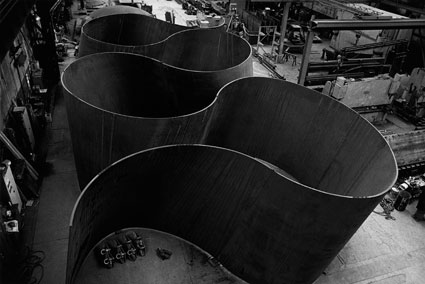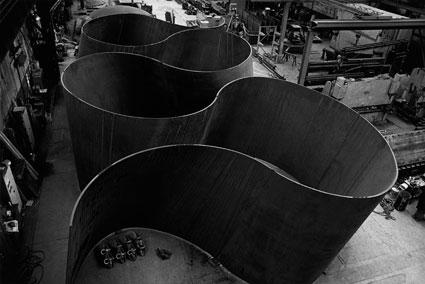For this installment of Ask a Curator, we thought the question was better handled by one of our conservators, so we handed this over to Senior Conservator John Hirx.
Hannah asks: I’ve seen many Serra sculptures, whether it be the two sculptures in St. Louis (Twain and Joe) or at a MOMA exhibition, and many of these sculptures have been both inside or outside. With the use of the cor-ten steel, does the patina change inside the museum environment as quickly, if at all, like outside Serra sculptures? Obviously, if it changes, it does so in a slower process, but does that change the overall aesthetic of Serra sculptures? Are they best seen outside or inside?

Richard Serra, "Band," 2006, purchased with funds provided by the Broad Contemporary Art Museum Foundation, photo by Lorenz Kienzle
Serra’s work can be seen and experienced both indoors and out, as site-specific work or not—his work doesn’t seem to fall into an “either/or” category.
Seasonal weather changes support the development of the aesthetically desirable Cor-ten patina. Air quality probably plays a role as well. The environment inside of BCAM, in terms of relative humidity (RH) and temperature, is closely monitored—hovering at about 50% RH and 68 degrees Fahrenheit, with minor fluctuations. The museum air also circulates through an air-conditioning system. Therefore, patina development is slowed.
At its best, a weathered Cor-ten surface develops a forest of richly colored dark brown crystals. If the crystals are not disturbed during formation, the sculpture has a unifying, monolithic appearance even though the patina varies greatly from place to place. However, one rarely encounters this because the surface is so often disturbed in some manner. Keeping in mind that most of Serra’s Cor-ten sculptures are large and have enormous surface area, it is impossible for the surface not to be disturbed. Weather or human intervention can act to make the surface active, so when crystals are disturbed, time and the outdoor environment or a surface treatment support new corrosion or patina development. Therefore, the overall aesthetic is an ongoing work in progress.
John Hirx, Senior Conservator



